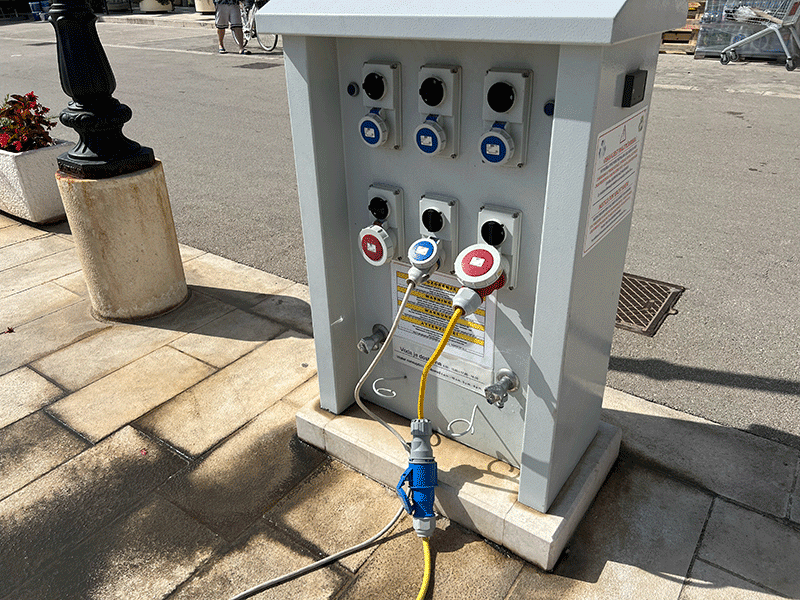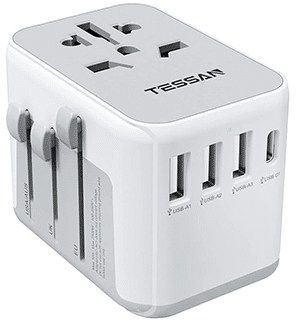Plan your dream yacht charter with NauticEd! Whether you prefer bareboat or captained, NauticEd is your trusted resource for unforgettable sailing vacations. We charge no fees—plus, our expert knowledge and extensive search capabilities often save you money. Start planning your next adventure today!
Quick Guide to Adapters and Chargers you Need for Yacht Charter
When chartering a yacht on a sailing vacation, you’re kinda going off-grid. Well, not really, there is plenty of electricity available and you’ll more than likely, depending on the destination, have cell service. So it’s more “off-ish grid”.
Here’s a guide to what you should take to ensure all your devices can be charged.
A Typical 220v AC Shore Power Box in Europe
At home, you have 110 volt or 220 volt AC electricity from the wall sockets. On a boat, the electricity comes from 2 sources, the 12 volt DC batteries, and the 110 volt or 220 volt AC generator if running.
Since the generator is a motor chewing up diesel, it is not always running so let’s discuss batteries first since that is your primary source of electricity.
Batteries
These output 12-volt DC electricity which is easily down-converted to 5 volt DC which is what all USB ports output. So USB power is always available.
Most boats these days have USB outlets in each cabin. But unless super modern, they will be USB-A type (the rectangular version) which probably does work for you new phone cable which is USB-C (the smaller oval version). Thus you should take a USB-A to USB-C adapter.
Some older boats don’t have USB outlets in cabins or in the salon – if so then they will have the old cigarette round-type plug. In that case, you will need a Cigarette lighter to USB adapter.
Inverters (120v or 240v output)
Many larger boats have an inverter. An inverter inverts the 12-volt battery electricity to 110v or 220v AC electricity. Thus the inverter runs off the battery power. It is a large electronic box mounted in a cabinet in the salon. So anything that needs AC voltage like a CPAP machine or laptop can be charged with the inverter. The inverter needs to be turned on to produce the AC electricity – BIG note, the inverter chews electricity. As much as 0.3 kWh per day – and with a 1.2 kwh battery capacity, just leaving the inverter on can chew as much as 25% of the energy stored in 1 house bank battery. Not good! So turn off your inverter when not using it.
Regardless, you can run or charge almost any small AC-required device using the boat’s inverter (if it has one). Hair dryers – well that has some considerations. An average hair dryer can consume up to 2000 watts. Most Inverters are rated at 2000 watts. The trouble is that the start-up power initially can require more electricity and therefore may overload and safely shut down the inverter. If you want to run a hairdryer off the inverter try to take with you a lower watt rating hair dryer (1500 w or less) – or use it on low power setting. Be prepared to not be able to use a hairdryer off the inverter.
CPAP machines only use up to 150 w and smaller units use 30w so these are easily run off the inverter. Some CPAPs are run on 12 volts BUT there may not be a 12v cigarette type outlet on modern boats. CPAP machines can not run off the 5-volt USB.
Laptops consume about 30-60 watts, so again, they are fine running off the inverter. They will NOT run of the 5v USB outlets.
If your boat does not have an inverter, you can take your own smaller 300-watt inverter to charge your laptop and run a small-wattage CPAP.
The output wall socket from an inverter will be either the American 110V style or the European Shuko 240V style. Prepare for either one – i.e. have both adapters available in your charter kit.
So here is a battery electricity run down.
You can charge phones and cameras and such from USB outlets if available
Laptops and CPAP you will need an inverter and maybe you will get by with a hairdryer off a 2000 watt inverter.
The Generator
The generator is an engine that runs off diesel and makes subsequent noise. It’s not pleasant to sleep with. But if you absolutely need air conditioning at night then you’re going to have to run the noisy thing all night. (some boats – very very few charter boats – have enough Lithium Ion battery capacity to run an air conditioner without the generator – but somehow you will have to recharge the batteries the next day – don’t expect this on your charter boat)
The generator will produce sufficient electricity at 110v or 220 v AC to charge anything you want. So if your boat has a generator – you’ll be golden.
Shore-Power
Generally, all ports in the Mediterranean and many elsewhere have shore-power. This is a big power outlet box on the dock which you can plug you boat into and viola – you have 110v or 220 v AC power throughout the boat – as much as you want! Note you will have to pay for the connection – sometimes 20€/night. But at least you have a quiet night’s sleep. Don’t run your generator in the marina – that is just rude to your neighbors.
Plug Adapters
Adapters don’t change the voltage, they only change the plug configuration from say USA to Euro, or Euro to USA, or Kiwi/Aussie to Euro/USA. Fortunately, these days almost every device can handle 220v or 110v – but check just in case. Especially a hair dryer. For example, a USA hair dryer might blow up if plugged into the generator or from shore-power 220v outlet. Or if you are bringing your European hair dryer to the Caribbean 110v – it will not like you in the same manner. Just check – many can handle both voltages – some automatically – some you have to remember to flick a small switch on the dryer itself. Something like the adapter below is a good one.
A Caveat to Everything and What to Bring
You might not get the exact boat you chartered for many various reasons – such as the person who rented it prior to you had not done NauticEd training and crashed the boat – or it just broke – or the generator broke.
So we recommend having a standard charter electrical kit that will cover all scenarios
In the kit put these items
- 12v cigarette lighter type to dual USB adapter
- USB-A to USB-C adapters
- multi USB output splitter block (to charge multiple devices off the same USB outlet)
- 12 v to 110v/220v 300w Inverter for CPAP and Laptop charging
- Adapters
- 220v Europlug to 110v USA AC adapter if you use 110v devices
- 110 v USA plug to 220 v Euro AC adapter if you use 220v devices
- Kiwis and Aussies bring a 220v kiwi/aussie plug to 220v euro adapter.
- If bringing a hair dryer make sure it is low wattage 1500 w max and make sure it can handle 220v as well as 110v
Your Adventure - Our Expertise
NauticEd are Yacht Charter Agents
NauticEd is your go-to resource for planning an unforgettable charter vacation, whether bareboat or captained. We don’t charge a fee – actually, we will probably save you money because of our extended search capabilities as well as our knowledge of worldwide locations (i.e., “we’ve been there”). So let us help you plan your next yacht charter vacation!







